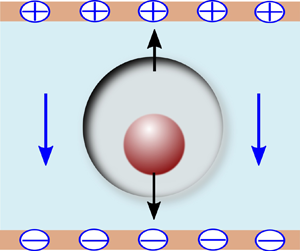Published online by Cambridge University Press: 16 May 2023

Eccentric compound drops, which are ubiquitous in many naturally inspired and engineering systems, can migrate under the sole presence of a uniform electric field, unlike the case of isolated single drops. Here, we report the migration of eccentric compound drops under a uniform electric field, imposed parallel to the line of centres of the constituting drops, by developing an approximate analytical model that applies to low Reynolds number limits under negligible droplet deformation, following axisymmetric considerations. In contrast to the sole influence of the electrohydrodynamic forces that has thus far been established to be emphatic for the eccentric configuration, here we report the additional effects induced by the dielectrophoretic forces to result in decisive manipulation in the drop migration. We show that the relative velocity between the inner and outer drops, which is a function of the eccentricity itself, dictates the dynamical evolution of the eccentricity variation under the competing electrohydrodynamic and dielectrophoretic interactions. This brings out four distinct regimes of the migration characteristics of the two drops based on their relative electro-physical properties. Our results reveal that an increase in eccentricity and the size ratio of the inner and outer droplets may induce monotonic or non-monotonic variation in the drop velocities, depending on the operating regime. We show how the interplay of various properties holds the control of selectively increasing or suppressing the eccentricity with time. These findings open up various avenues of electrically manipulative motion of encapsulated fluidic phases in various applications encompassing engineering and biology.